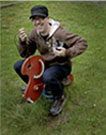Luc Courchesne

Title :You are here
Abstract:
The continuing expansion of the visible domain, increasingly including and giving force (and reality) to the creations of our imagination and to formerly inaccessible places and dimensions of our unfolding universe, has produced a radical shift of the shared concepts of time and space. Suddenly, the statement « you are here » has a very different meaning. Thanks to the proliferation and increased mastery of interactive, immersive and socially engaging media, we have passed beyond the simple curiosity for technologies to find ourselves, as MacLuhan professed, dressed and immersed in them. Immersed indeed we are, collectively engaged in a « reality jam » with the physical, the artificial, the augmented, and the virtual. In the process, we have turned from spectators to users, visitors and now inhabitants of our own crafts. Questions such as « Who am I? », « Who are you? », « Where are we? », « How are we supposed to behave? », are now being asked with new relevance and urgency. Survival skills such as conversation, posture, attitude, or simply what to wear, are being reformulated on the fly by the natives and immigrants of this new territory that does not always perfectly accommodates the biological features we inherited from evolution.
Bio
Luc Courchesne took part in the emergence of new media arts in the nineteen eighties when, as a videographer inspired by a generation of experimental filmmakers such as Michael Snow and Hollis Frampton, he was introduced to computers and interactive video technologies. Initially, his work focused on portraiture which he attempted to renovate with his use of interactive technologies to simulate conversion. He later moved toward landscape art which he made interactive and immersive with the Panoscope 360°, a system and method he invented to, in his words, « transform the spectator of the artwork into a visitor ». He created to date over 30 installation works that were exhibited in close to 100 venues the world over including the ICA in Boston in 1983, the Museum of Modern Art in New York in 1994, The ZKM/Karlsruhe since 1997, Paris's La Villette in 1999, Helsinki's Kiasma in 1997 and 2003, The Museum of New South Wales, in 1996 and 2001, the Montreal Museum of Fine Arts in 2007 and the National Art Museum of China in 2008. He was awarded the Grand Prize of The ICC Biennale in Tokyo (1997) and an award of distinction at Prix Ars Electronica in Linz (1999).
Courchesne, who graduated from the Nova Scotia College of Art and Design (1974) and from the Massachusetts Institute of Technology (1984), is now director of the School of industrial design at University of Montreal, a board member of the Conseil des arts et des lettres du Québec and a founding member of the Society for Arts and Technology.
Gonzalo Frasca

Title: Game experience may vary: Understanding Play
Abstract:
Why do we call it game research and not play research? For the last decade of videogame studies, most of the attention has been paid to games as formal entities. At first, games seem easier to understand: they generally have clear rules and goals. They would be perfect machineries with formal mechanics if it was not for one factor: humans and their stubborn love for misbehaving. This talk provides an ontological approach to play and games and will analyze the relationship between the two concepts by taking into account the player's mindset. If this sounds too theoretical and abstract, there's no need to worry. It holds the key to better understanding the differences between casual and hardcore games.
Bio
Gonzalo Frasca (1972) is a game developer & researcher. He's co-founder of Powerful Robot Games, a game studio based in Uruguay with clients including Cartoon Network, Lucasfilms, Mattel and BBC. His latest hit game for Cartoon Network, AwesomeHouseParty.com, gathered over 22 million player accounts. Frasca obtained his PhD on games at the Center for Computer Games Research in Denmark. His research focuses on game design and rhetoric, particularly educational and political games. In 2003, he co-developed the first official videogame ever created for a US Presidential campaign. In a previous life, he blogged at Ludology.org
Nicolas Gaume

Title : The new Pact: how online worlds forge a new form of alliance between players & designers
Abstract
Today's Pop Culture is tomorrow's classic. Entertainment is often able to reflect a society's questions and anxieties of the day. We will discuss how and why today's Digital Generation has replaced their grandparents' heroes and their parents' anti-heroes by their very own avatars. How and why the empathy with heroes that has traditionally been utilized by movies has been gradually overtaken by the personalized and immersive experience of games as lived through the eyes of an avatar? How multiplayer activities are now establishing new social paradigms where these avatars help us all deal with the natural schizophrenia of everyday life by allowing us to explore our possible selves. The Social Networks boom has demonstrated our appetite for connections with others; and games our appetite for second lives, our desire to involve ourselves and master complex worlds. Perhaps, tomorrow new public Agoras will be created from a new generation of Virtual Worlds built using the grammar that video games have forged over the last 40 years...
Bio
Nicolas Gaume founded in 1990, at the age of 19, Kalisto Entertainment, a video game development studio. Over its 12 years of life, Kalisto produced more than 50 titles for PC and consoles. Kalisto also worked with Orange to launch their mobile games efforts. The company employed a staff of over 350 people in the USA, Japan and France. Besides his Kalisto venture, Nicolas Gaume founded in 1994, NGM Productions, a children book publishing company in China. NGM published popular French series such as "Père Castor" (Flammarion) or "Les Incollables/Brain Quest" (Play Bac) between 1994 and 1999, when the company was sold. He also co-founded, in 1995, one of the first French web agency, Wcube, sold to Swedish group, Framfab, and, in 2000, a wine promotion site, winealley.com. He was also board member of the French media group Sud-Ouest, of the TV animation production company, Xilam & of the German data management software publisher, NXN, sold in 2004 to Avid. Between July 2002 and May 2005, Nicolas has worked as a consultant advising media group such as AOL, Orange or Lagardère and game companies such as Codemasters or Ubisoft, primarily on their development & partnerships strategies. For thee years, Nicolas Gaume was then Senior VP & GM of the mobile games & applications division of Cellfish Media, a Lagardère company. Early 2008, he founded a new company, Mimesis Republic, focusing on the design, development and operation of virtual worlds and social networks. He also currently serves as chairman of the French national video game development school -ENJMIN- and president of the French game developers association, SNJV.
Susan Gold

Title :The International Game Developer Association (IGDA) Education Special Interest Group (EdSIG)
Abstract :
Developed in 2006 the IGDA EdSIG mission is to create a community resource that will strengthen the academic membership of the IGDA while enhancing the education of future and current game developers. Since the inception of the SIG there have been two major projects: 1) 2008 IGDA Curriculum Framework which has become the standard for game education; 2) The Global Game Jam where experimentation, innovation and creativity are the main components of it's success. The IGDA EdSIG is tries to create collaborations and partnerships globally to promote game studies. Bio: Director of Game Program Review, Chairperson, IGDA Education SIG Susan is director of the Game Program Review, a consulting firm specializing in game education for both industry professionals and students. The firm offers a speakers bureau with workshops and lectures specific to the game industry. The firm also serves as an academic consultancy for schools developing game curricula. Susan's personal focus is on collaboration, which resulted in the 1st Annual Global Game Jam (http://globalgamejam.org), an experiment in creativity and innovation with 1650 participants in 53 locations in 23 countries that inspired 360 games in a 48 hour time span. Susan is also chair of the IGDA Education SIG, sits on a number of university advisory boards worldwide. Susan's work with the IGDA Ed SIG has created many resources for instructors in game education. Currently, she is building an outreach campaign to meet the needs of educators worldwide, and she continues to develop tools and resources for educator professional development. Throughout her career, Susan has demonstrated her natural talent of working with industry to help build relationships and integrate their recommendations in education. Susan is an artist, teacher, and activist with a specialization in digital art, new media and videogames. Her artwork and writing have been featured in numerous galleries, museums and publications.
Michael Stora

Title: Story of a video game workshop: "Ico", an interactive fairy tale for children less interaction.
Abstract:
Since several years, I use the video game as a therapeutic object. This new mediation seems pertinent for children that we qualified "limit". Those children are more in the game in the gambling sense, than in the Winnicot's play. The video game is relevant in a clinic sense for two reasons essential. The first reason is that mediation is in picture and children and adolescents have an intimate attachment to these who have the power to do emerge affects and words that in generally are repressed. The second reason is this meeting between narcissism pathology and the use of video game as a place of virtue's passage in act. The acting becomes symbolic and the conflict showed by the narration of the video game is in a dynamic point between drive and narcissism. Key words: Video game, interactive, narcissism, drive, therapeutic mediation. Bio: After my education as a film-maker, I became a clinical psychologist, and, ever since I am constantly preoccupied by the unconscious links between human being and images. In 2000, I created a Partnership Association named: "Observatory of Digital World in Human Studies", for developing new theories on Interactivity, this new connection to images. I, moreover, used video games as a therapeutic tool for children with violent behaviour troubles. In 2008, I launched the Company "Implicit Game" with the aim of creating video games for healing. I am currently working on a project of an on-line game for overweighed teenagers."
Yukiharu Sambe

Title: The next technology of Japanese Arcade entertainment
The contents market scale of Japan is $20billion. The arcade game is $6.00 billion while Home console contents is $3.50 billion and the cellular phone contents is $4.20 billion. The success of recent Nintendo is based on applying sensors on the Home console market. On the other hand, Arcade entertainment machines used the technology of sensors, mechanical things and many kind of displays, from it's early stage. Arcade invented many entertainments such as the Fun photo machine, the Music games, the Train driving simulators and many new entertainments. Arcade entertainment is limitless of applying technology. I will present some next applyable technologies for arcade entertainment with some concepts/ideas.
 3-5 september CNAM
3-5 september CNAM 3-5 september CNAM
3-5 september CNAM